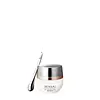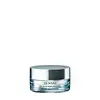What's inside
What's inside
 Key Ingredients
Key Ingredients

 Benefits
Benefits

 Concerns
Concerns

 Ingredients Side-by-side
Ingredients Side-by-side

Water
Skin ConditioningHydrogenated Polydecene
EmollientGlycerin
HumectantMaltitol
HumectantTriethylhexanoin
MaskingDipropylene Glycol
HumectantBehenyl Alcohol
EmollientCera Alba
EmollientGlyceryl Stearate
EmollientHydrogenated Castor Oil Hydroxystearate
Skin ConditioningCera Microcristallina
Emulsion StabilisingCetyl Palmitate
EmollientCeteth-20
CleansingDimethicone
EmollientNiacinamide
SmoothingSodium Stearoyl Glutamate
CleansingStearic Acid
CleansingButylene Glycol
HumectantDipotassium Glycyrrhizate
HumectantMethylserine
Skin ConditioningXanthan Gum
EmulsifyingAcetyl Glucosamine
Skin ConditioningAlcohol
AntimicrobialDisodium EDTA
Fucus Vesiculosus Extract
EmollientDimethoxy Di-P-Cresol
AntioxidantAlthaea Officinalis Root Extract
Skin ConditioningHydrolyzed Silk
HumectantZostera Marina Extract
Skin ConditioningPyracantha Fortuneana Fruit Extract
Skin ConditioningPoria Cocos Extract
Skin ConditioningHydrolyzed Conchiolin Protein
Skin ConditioningBHT
AntioxidantPhenoxyethanol
PreservativeSodium Benzoate
MaskingWater, Hydrogenated Polydecene, Glycerin, Maltitol, Triethylhexanoin, Dipropylene Glycol, Behenyl Alcohol, Cera Alba, Glyceryl Stearate, Hydrogenated Castor Oil Hydroxystearate, Cera Microcristallina, Cetyl Palmitate, Ceteth-20, Dimethicone, Niacinamide, Sodium Stearoyl Glutamate, Stearic Acid, Butylene Glycol, Dipotassium Glycyrrhizate, Methylserine, Xanthan Gum, Acetyl Glucosamine, Alcohol, Disodium EDTA, Fucus Vesiculosus Extract, Dimethoxy Di-P-Cresol, Althaea Officinalis Root Extract, Hydrolyzed Silk, Zostera Marina Extract, Pyracantha Fortuneana Fruit Extract, Poria Cocos Extract, Hydrolyzed Conchiolin Protein, BHT, Phenoxyethanol, Sodium Benzoate
Water
Skin ConditioningHydrogenated Polydecene
EmollientSorbitol
HumectantDipropylene Glycol
HumectantGlycerin
HumectantOctyldodecyl Myristate
EmollientButylene Glycol
HumectantTriisostearin
Skin ConditioningPhytosteryl Macadamiate
Skin ConditioningBehenyl Alcohol
EmollientCetyl Palmitate
EmollientIsocetyl Myristate
EmollientPhytosteryl/Isostearyl/Cetyl/Stearyl/Behenyl Dimer Dilinoleate
Skin ConditioningPhenoxyethanol
PreservativeCholesterol
EmollientHydrogenated Lecithin
EmulsifyingIsostearic Acid
CleansingCarbomer
Emulsion StabilisingParfum
MaskingXanthan Gum
EmulsifyingMethylserine
Skin ConditioningPotassium Hydroxide
BufferingAcetyl Glucosamine
Skin ConditioningDipotassium Glycyrrhizate
HumectantNiacinamide
SmoothingPalmitic Acid
EmollientPropylene Glycol Hyaluronate
EmulsifyingPrunus Armeniaca Juice
MoisturisingAlcohol
AntimicrobialDisodium EDTA
Dimethoxy Di-P-Cresol
AntioxidantLinalool
PerfumingPyracantha Fortuneana Fruit Extract
Skin ConditioningAlpha-Isomethyl Ionone
PerfumingCitronellol
PerfumingLimonene
PerfumingBenzyl Benzoate
AntimicrobialHydrolyzed Silk
HumectantGeraniol
PerfumingHexyl Cinnamal
PerfumingPrunus Armeniaca Kernel Extract
Skin ConditioningRoyal Jelly Extract
Skin ConditioningSodium Hyaluronate
HumectantTocopherol
AntioxidantMethylparaben
PreservativeSalicylic Acid
MaskingHydrolyzed Conchiolin Protein
Skin ConditioningPropylene Glycol
HumectantIsobutyl Methyl Tetrahydropyranol
MaskingMethyldihydrojasmonate
MaskingPhenethyl Alcohol
MaskingWater, Hydrogenated Polydecene, Sorbitol, Dipropylene Glycol, Glycerin, Octyldodecyl Myristate, Butylene Glycol, Triisostearin, Phytosteryl Macadamiate, Behenyl Alcohol, Cetyl Palmitate, Isocetyl Myristate, Phytosteryl/Isostearyl/Cetyl/Stearyl/Behenyl Dimer Dilinoleate, Phenoxyethanol, Cholesterol, Hydrogenated Lecithin, Isostearic Acid, Carbomer, Parfum, Xanthan Gum, Methylserine, Potassium Hydroxide, Acetyl Glucosamine, Dipotassium Glycyrrhizate, Niacinamide, Palmitic Acid, Propylene Glycol Hyaluronate, Prunus Armeniaca Juice, Alcohol, Disodium EDTA, Dimethoxy Di-P-Cresol, Linalool, Pyracantha Fortuneana Fruit Extract, Alpha-Isomethyl Ionone, Citronellol, Limonene, Benzyl Benzoate, Hydrolyzed Silk, Geraniol, Hexyl Cinnamal, Prunus Armeniaca Kernel Extract, Royal Jelly Extract, Sodium Hyaluronate, Tocopherol, Methylparaben, Salicylic Acid, Hydrolyzed Conchiolin Protein, Propylene Glycol, Isobutyl Methyl Tetrahydropyranol, Methyldihydrojasmonate, Phenethyl Alcohol
Ingredients Explained
These ingredients are found in both products.
Ingredients higher up in an ingredient list are typically present in a larger amount.
Acetyl Glucosamine is an antioxidant and humectant. It is an amino acid sugar and is naturally found in our skin.
The cool thing about this ingredient? It helps the skin produce hyaluronic acid and boost hydration. It also has antioxidant benefits to protect skin cells.
When paired with niacinamide, Acetyl Glucosamine has been shown to be effective at reducing discoloration.
Learn more about Acetyl GlucosamineAlcohol comes in many different forms. Different types of alcohol will have different effects on skin. This ingredient is usually an astringent alcohol.
These alcohols are drying on the skin. They may strip away your skin's natural oils and even damage your skin barrier. Astringent alcohols may also irritate skin.
Other types of astringent alcohols include:
According to the National Rosacea Society based in the US, you should be mindful of products with these alcohols in the top half of ingredients.
Any type of sanitizing product will have high amounts of alcohol to help kill bacteria and viruses.
Fatty alcohols come from plant oils such as coconut oil. These can help hydrate the skin and are non-irritating. Some fatty alcohols include cetyl and stearyl alcohol.
Learn more about AlcoholBehenyl Alcohol is a type of fatty alcohol (these are different from the drying, solvent alcohols).
Fatty Alcohols have hydrating properties and are most often used as an emollient or to thicken a product. They are usually derived from natural fats and oils; behenyl alcohol is derived from the fats of vegetable oils.
Emollients help keep your skin soft and hydrated by creating a film that traps moisture in.
In 2000, Behenyl Alcohol was approved by the US as medicine to reduce the duration of cold sores.
Learn more about Behenyl AlcoholButylene Glycol (or BG) is used within cosmetic products for a few different reasons:
Overall, Butylene Glycol is a safe and well-rounded ingredient that works well with other ingredients.
Though this ingredient works well with most skin types, some people with sensitive skin may experience a reaction such as allergic rashes, closed comedones, or itchiness.
Learn more about Butylene GlycolCetyl Palmitate is a wax-like substance.
It comes from palmitic acid and palmityl alcohol. Cetyl Palmitate may not be safe for Malassezia folliculitis, or fungal-acne.
This ingredient is naturally found in the guava fruit and stony corals.
Learn more about Cetyl PalmitateDimethoxy Di-P-Cresol is an antioxidant.
Dipotassium Glycyrrhizate comes from licorice root.
Extracts of licorice have demonstrated to have antibacterial, anti‐inflammatory, antiviral, antioxidant properties.
One component, glabridin, has extra potent antioxidant and soothing properties. It has also been found to block pigmentation from UVB rays in guinea pigs.
Licorice Root also contains a flavonoid. Flavonoids are a natural substance from in plants. Flavonoids also have antioxidant properties.
Another component, glycyrrhizin, has been found to have anti-inflammatory and antimicrobial benefits. This may make licorice root extract effective at treating acne. However, more research is needed to support this.
Liquiritin is one of the flavone compounds found in licorice. It has been found to help lighten skin by preventing tyrosinase from reacting with tyrosine. When the two react, protein is converted to melanin. Melanin is the substance in your body that gives your features pigmentation.
Licorice root is native to Southern Europe and Asia. It has been used in traditional Chinese medicine to help with respiratory issues.
Learn more about Dipotassium GlycyrrhizateDipropylene Glycol is a synthetically created humectant, stabilizer, and solvent.
This ingredient helps:
Dipropylene glycol is technically an alcohol, but it belongs to the glycol family (often considered part of the ‘good’ alcohols). This means it is hydrating and gentle on skin unlike drying solvent alcohols like denatured alcohol.
As a masking agent, Dipropylene Glycol can be used to cover the smell of other ingredients. However, it does not have a scent.
Studies show Dipropylene Glycol is considered safe to use in skincare.
Learn more about Dipropylene GlycolDisodium EDTA plays a role in making products more stable by aiding other preservatives.
It is a chelating agent, meaning it neutralizes metal ions that may be found in a product.
Disodium EDTA is a salt of edetic acid and is found to be safe in cosmetic ingredients.
Learn more about Disodium EDTAGlycerin is already naturally found in your skin. It helps moisturize and protect your skin.
A study from 2016 found glycerin to be more effective as a humectant than AHAs and hyaluronic acid.
As a humectant, it helps the skin stay hydrated by pulling moisture to your skin. The low molecular weight of glycerin allows it to pull moisture into the deeper layers of your skin.
Hydrated skin improves your skin barrier; Your skin barrier helps protect against irritants and bacteria.
Glycerin has also been found to have antimicrobial and antiviral properties. Due to these properties, glycerin is often used in wound and burn treatments.
In cosmetics, glycerin is usually derived from plants such as soybean or palm. However, it can also be sourced from animals, such as tallow or animal fat.
This ingredient is organic, colorless, odorless, and non-toxic.
Glycerin is the name for this ingredient in American English. British English uses Glycerol/Glycerine.
Learn more about GlycerinHydrogenated Polydecene is an emollient. It creates a non-occlusive film on the skin that offers extra protection for your skin barrier.
The texture of Hydrogenated Polydecene ranges from light and silky to rich.
Hydrogenated Polydecene is the end compound of controlled hydrogenation of Polydecene.
Learn more about Hydrogenated PolydeceneWe don't have a description for Hydrolyzed Conchiolin Protein yet.
You can find hydrolyzed silk in both haircare and skincare products. According to a manufacturer, it can help improve skin and hair hydration.
This ingredient is created by adding acid or enzymes to 'hydrolyze' silk protein.
Due to the origins of this ingredient, it is not vegan. Silk is an animal product from silkworms.
Depending on the source, this ingredient can be considered cruelty-free. It is created from left-over cocoons of silkworms. We recommend reaching out to the brand if you have questions about where their hydrolyzed silk comes from.
Learn more about Hydrolyzed SilkWe don't have a description for Methylserine yet.
Niacinamide is a multitasking form of vitamin B3 that strengthens the skin barrier, reduces pores and dark spots, regulates oil, and improves signs of aging.
And the best part? It's gentle and well-tolerated by most skin types, including sensitive and reactive skin.
You might have heard of "niacin flush", or the reddening of skin that causes itchiness. Niacinamide has not been found to cause this.
In very rare cases, some individuals may not be able to tolerate niacinamide at all or experience an allergic reaction to it.
If you are experiencing flaking, irritation, and dryness with this ingredient, be sure to double check all your products as this ingredient can be found in all categories of skincare.
When incorporating niacinamide into your routine, look out for concentration amounts. Typically, 5% niacinamide provides benefits such as fading dark spots. However, if you have sensitive skin, it is better to begin with a smaller concentration.
When you apply niacinamide to your skin, your body converts it into nicotinamide adenine dinucleotide (NAD). NAD is an essential coenzyme that is already found in your cells as "fuel" and powers countless biological processes.
In your skin, NAD helps repair cell damage, produce new healthy cells, support collagen production, strengthen the skin barrier, and fight environmental stressors (like UV and pollution).
Our natural NAD levels start to decline with age, leading to slower skin repair, visible aging, and a weaker skin barrier. By providing your skin niacinamide, you're recharging your skin's NAD levels. This leads to stronger, healthier, and younger looking skin.
Another name for vitamin B3 is nicotinamide. This vitamin is water-soluble and our bodies don't store it. We obtain Vitamin B3 from either food or skincare. Meat, fish, wheat, yeast, and leafy greens contain vitamin B3.
The type of niacinamide used in skincare is synthetically created.
Learn more about NiacinamidePhenoxyethanol is a preservative that has germicide, antimicrobial, and aromatic properties. Studies show that phenoxyethanol can prevent microbial growth. By itself, it has a scent that is similar to that of a rose.
It's often used in formulations along with Caprylyl Glycol to preserve the shelf life of products.
We don't have a description for Pyracantha Fortuneana Fruit Extract yet.
Water. It's the most common cosmetic ingredient of all. You'll usually see it at the top of ingredient lists, meaning that it makes up the largest part of the product.
So why is it so popular? Water most often acts as a solvent - this means that it helps dissolve other ingredients into the formulation.
You'll also recognize water as that liquid we all need to stay alive. If you see this, drink a glass of water. Stay hydrated!
Learn more about WaterXanthan gum is used as a stabilizer and thickener within cosmetic products. It helps give products a sticky, thick feeling - preventing them from being too runny.
On the technical side of things, xanthan gum is a polysaccharide - a combination consisting of multiple sugar molecules bonded together.
Xanthan gum is a pretty common and great ingredient. It is a natural, non-toxic, non-irritating ingredient that is also commonly used in food products.
Learn more about Xanthan Gum